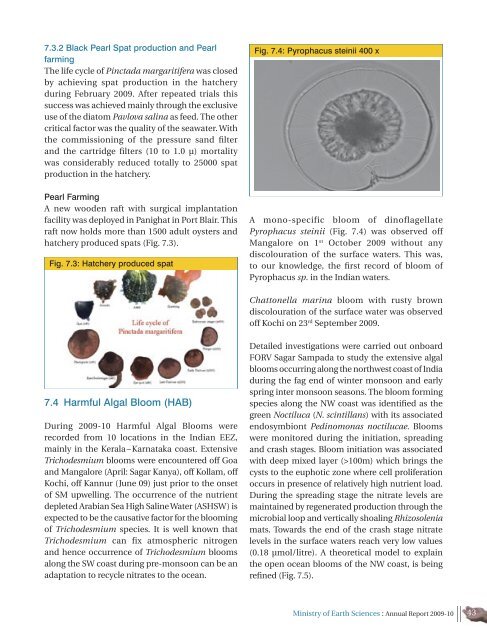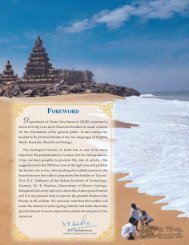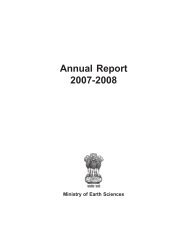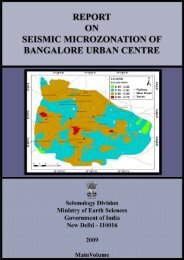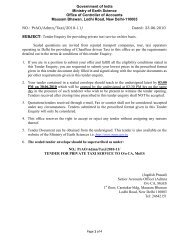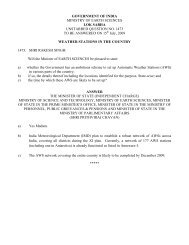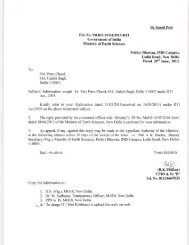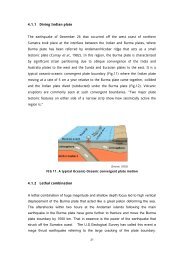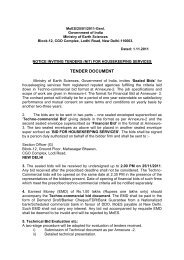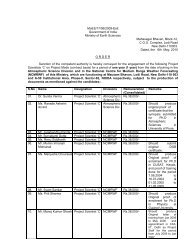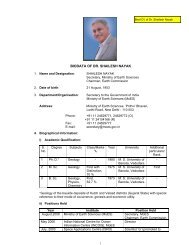Annual Report 2009-2010 - Ministry Of Earth Sciences
Annual Report 2009-2010 - Ministry Of Earth Sciences
Annual Report 2009-2010 - Ministry Of Earth Sciences
Create successful ePaper yourself
Turn your PDF publications into a flip-book with our unique Google optimized e-Paper software.
7.3.2 Black Pearl Spat production and Pearl<br />
farming<br />
The life cycle of Pinctada margaritifera was closed<br />
by achieving spat production in the hatchery<br />
during February <strong>2009</strong>. After repeated trials this<br />
success was achieved mainly through the exclusive<br />
use of the diatom Pavlova salina as feed. The other<br />
critical factor was the quality of the seawater. With<br />
the commissioning of the pressure sand filter<br />
and the cartridge filters (10 to 1.0 µ) mortality<br />
was considerably reduced totally to 25000 spat<br />
production in the hatchery.<br />
Pearl Farming<br />
A new wooden raft with surgical implantation<br />
facility was deployed in Panighat in Port Blair. This<br />
raft now holds more than 1500 adult oysters and<br />
hatchery produced spats (Fig. 7.3).<br />
Fig. 7.3: Hatchery produced spat<br />
Fig. 7.4: Pyrophacus steinii 400 x<br />
A mono-specific bloom of dinoflagellate<br />
Pyrophacus steinii (Fig. 7.4) was observed off<br />
Mangalore on 1 st October <strong>2009</strong> without any<br />
discolouration of the surface waters. This was,<br />
to our knowledge, the first record of bloom of<br />
Pyrophacus sp. in the Indian waters.<br />
Chattonella marina bloom with rusty brown<br />
discolouration of the surface water was observed<br />
off Kochi on 23 rd September <strong>2009</strong>.<br />
7.4 Harmful Algal Bloom (HAB)<br />
During <strong>2009</strong>-10 Harmful Algal Blooms were<br />
recorded from 10 locations in the Indian EEZ,<br />
mainly in the Kerala – Karnataka coast. Extensive<br />
Trichodesmium blooms were encountered off Goa<br />
and Mangalore (April: Sagar Kanya), off Kollam, off<br />
Kochi, off Kannur (June 09) just prior to the onset<br />
of SM upwelling. The occurrence of the nutrient<br />
depleted Arabian Sea High Saline Water (ASHSW) is<br />
expected to be the causative factor for the blooming<br />
of Trichodesmium species. It is well known that<br />
Trichodesmium can fix atmospheric nitrogen<br />
and hence occurrence of Trichodesmium blooms<br />
along the SW coast during pre-monsoon can be an<br />
adaptation to recycle nitrates to the ocean.<br />
Detailed investigations were carried out onboard<br />
FORV Sagar Sampada to study the extensive algal<br />
blooms occurring along the northwest coast of India<br />
during the fag end of winter monsoon and early<br />
spring inter monsoon seasons. The bloom forming<br />
species along the NW coast was identified as the<br />
green Noctiluca (N. scintillans) with its associated<br />
endosymbiont Pedinomonas noctilucae. Blooms<br />
were monitored during the initiation, spreading<br />
and crash stages. Bloom initiation was associated<br />
with deep mixed layer (>100m) which brings the<br />
cysts to the euphotic zone where cell proliferation<br />
occurs in presence of relatively high nutrient load.<br />
During the spreading stage the nitrate levels are<br />
maintained by regenerated production through the<br />
microbial loop and vertically shoaling Rhizosolenia<br />
mats. Towards the end of the crash stage nitrate<br />
levels in the surface waters reach very low values<br />
(0.18 µmol/litre). A theoretical model to explain<br />
the open ocean blooms of the NW coast, is being<br />
refined (Fig. 7.5).<br />
<strong>Ministry</strong> of <strong>Earth</strong> <strong>Sciences</strong> : <strong>Annual</strong> <strong>Report</strong> <strong>2009</strong>-10 43


